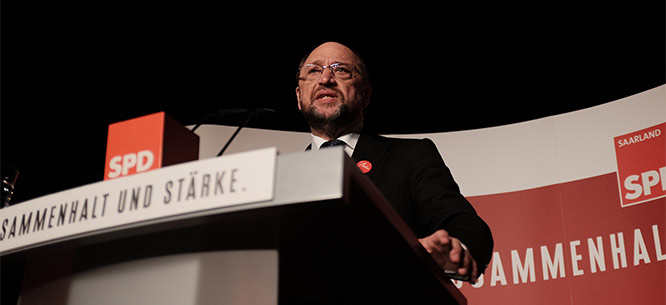Germany: The End of the Mighty SPD?
Germany: The End of the Mighty SPD?
Once an anchor of European social democracy, Germany’s Social Democratic Party has suffered its worst loss since 1932. Can it reclaim the mantle of opposition from the far-right AfD?

Last Sunday’s German elections revealed many worrying trends. A country in relatively good economic health, with relatively low unemployment, a strong manufacturing sector (and hence a large number of well-paying and unionized blue-collar jobs), and decent growth as well as a Nazi past made the radical-populist AfD (“Alternative for Germany”) the third-largest party, with 13 percent of the vote. For the first time in the postwar era a far-right party will be represented in the German parliament. Equally worrying—and directly related—is the decline of Germany’s two historic governing parties: the Christian Democrats (CDU/CSU) and the Social Democrats (the SPD). The SPD is in even worse shape than its center-right counterpart, having received only 20.5 percent of the vote. This is the lowest vote share it has received since the Second World War. The last time the party did this poorly was in 1932, when it lost its position as the Weimar Republic’s traditionally strongest party to the Nazis.
Since the late nineteenth century the SPD has been the most important social democratic party in the world—the strongest and best organized, with the most influential theorists and whose internal debates and decisions had repercussions far beyond the country’s borders. Perhaps not surprisingly given this historic “trend-setting” role, the SPD’s precipitous decline reflects a larger trend: all across Europe social democratic and center-left parties have been reduced to shadows of their former selves. A closer look at what happened to the SPD in the recent German election provides insight into what is going on with the social-democratic or center-left across Europe.
Historically the SPD, like other social-democratic and center-left parties, acted as the champion of workers, the poor, the disenfranchised, and the disaffected, integrating them into democratic politics and representing their interests. The SPD is no longer the default choice of these groups. It lost support within all socioeconomic categories, indeed even only winning about 20 percent of working-class votes. It did win almost 30 percent of the votes of those in the very lowest educational category, but less than 20 percent of the votes in every other. The only age group it performed relatively well in was the over-60 category, gaining about 25 percent of these voters, but among every other age category it got only about 20 percent or less.
In the East, Germany’s most “left-behind” region, the SPD is no longer even the main opposition party, having lost that role to the AfD. The AfD increased its vote share among all age groups (with its best showing in the 30–44 age group); got 20 percent of the working class vote; and attracted a large number of voters who voted left in the last elections: 500,000 SPD voters and a higher proportion of far-left Die Linke voters than those of any other party defected to the AfD.
The SPD’s decline means it is no longer able to anchor a majority coalition—even joining with Die Linke and the Greens would not push the left over 50 percent. This has rebalanced the German political order from its postwar norm of alternating center-left and center-right governments, since an SPD-led government is not feasible. Indeed, the SPD’s electoral decline has left it in a terrible conundrum: if it joins the CDU/CSU as a junior partner, as it did after the last election, it waters downs its appeal even further and thus hastens its electoral decline, but if it does not, its current vote share means it has no viable way of gaining power.
But beyond electoral calculations, the SPD’s decline reflects a more fundamental shift in German—and European—politics. Parties lose voters because they do not offer them attractive and distinctive solutions to the problems they and their societies face. And this is most certainly true of the SPD and much of the rest of the European center-left. In the days since the election many within the SPD have acknowledged this, bemoaning the party’s inability to offer anything but “tweaks” to the status quo and almost completely lacking a vision for Germany’s future.
As in the rest of Europe, in Germany this has enabled the radical right-wing populist AfD to present itself as the main alternative to the status quo; that identification is even built into the party’s name. And indeed, many voters see AfD this way. Along with immigration and national sovereignty issues, surveys make clear that the main reason people voted for AfD was dissatisfaction with existing parties and the overall state of German democracy. This represents both a warning and an opportunity. A warning because such surveys make clear that underneath Germany’s relative political calm and economic prosperity, significant fears, dissatisfaction, and discomfort exist. If and when Merkel goes, or a new, more fractious CDU-led coalition spends more time bickering than dealing with Germany’s domestic and European challenges, fear, dissatisfaction, and discomfort will continue to spread. But this also represents an opportunity. If the SPD can figure out once again what it stands for, if it can offer the electorate attractive, distinctive, and viable solutions to contemporary problems, voters will come back to it since currently, at least, AfD voters, like the voters for most populist parties, are motivated as much if not more by frustration with existing alternatives as they are by any positive identification with the far right.
Sheri Berman is a professor of political science at Barnard College.






